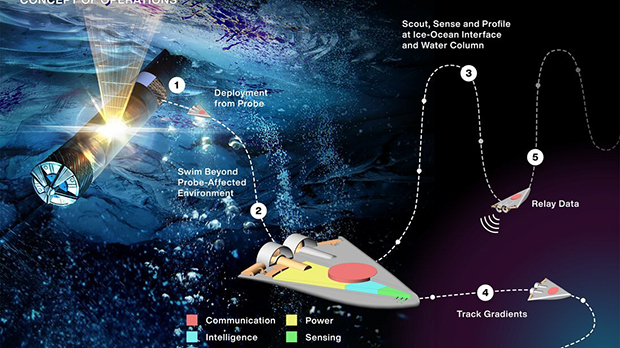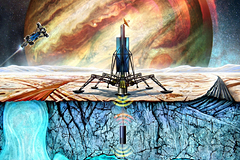Robotics Engineer at NASA Jet Propulsion Laboratory (Southern California) Ethan Shaler proposed to study the subglacial oceans on the Europa and Enceladus satellites with the help of a swarm of tiny robots. According to the idea of the specialist, the robots will be inside a probe tunneling into the icy crust of the satellite, and then will be released into the water when the "mother ship" reaches the ocean. This is reported in a press release on the official website of the laboratory.
The key difference between SWIM and similar projects is the small size of the robot swimmers, which will allow them to be compactly placed inside the probe, as well as conduct an effective search for signs of life in the alien ocean. The project provides for the creation of wedge-shaped robots with a length of about 12 centimeters and a volume of 60-75 cubic centimeters. Approximately 40 robots can be placed in the cargo compartment of the cryobot with a length of 10 centimeters and a diameter of 25 centimeters, which takes up about 15 percent of the total payload. The remaining volume can be used for less mobile, but more powerful scientific instruments capable of conducting stationary measurements and collecting data over time.
The use of a swarm of robots will solve several problems related to the study of subglacial oceans using probes. The Cryobot will be connected via cable to the ground landing module, which will serve as a communication node with dispatchers on the Ground. Thus, the probe will not be able to go far beyond the exit point from the ice crust into the ocean. In addition, the robots will collect data away from the cryobot, whose nuclear battery, used to melt ice, will create a heat bubble, potentially causing reactions that change the chemical composition of water.
 |
| Exploration of the subglacial ocean of Europe. |
| Source: Jet Propulsion Laboratory |
SWIM also provides for the simulation of swarming behavior of fish and birds, which will reduce errors in the data, as well as detect temperature and salinity gradients with greater accuracy. Each robot will be equipped with its own propulsion system, on-board computer and ultrasonic communication system, as well as temperature, salinity, acidity and pressure sensors. Tools for monitoring biomarkers indicating the presence of life are provided as part of the second phase of the study.
To develop the concept of Sensing With Independent Micro-Swimmers (SWIM), Shaler and his team received 600 thousand dollars as part of the NASA Innovative Advanced Concepts (NIAC) program. NIAC provides funding for revolutionary developments in the field of aeronautics and astronautics that may affect future NASA missions. The engineers plan to spend the grant on creating various prototypes that will be printed on a 3D printer and testing them over the next two years.

